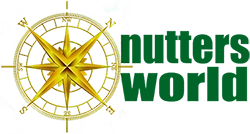Bronze & Iron Age Shipbuilding in the Mediterranean
Early Bronze Age Shipbuilding in the Mediterranean: Aegean & Egypt
Early Bronze Age ship depictions and construction in the Aegean (Cycladic frying pans, Minoan models, Dokos shipwreck) and Egypt (Abydos boats, Khufu's ship, Cheops Ship) c. 3000-2000 BC.
By Nick Nutter on 2025-04-24 | Last Updated 2025-05-20 | Bronze & Iron Age Shipbuilding in the Mediterranean
This article has been visited 3,363 times

Khufu Ship. Image from Wikipedia
Early Bronze Age Ship Depictions in the Aegean
The Early Bronze Age in the Aegean region, lasting approximately from 3000 to 2000 BC, saw the emergence of distinct cultures with a notable connection to the sea. Among these, the Cycladic civilization, centred on the islands of the central Aegean, is particularly renowned for its maritime activities and the artistic expressions thereof.
Ships in Rock Carvings in the Aegean
Dating from 3300 to 2500 BC (the late Final Neolithic/Proto-Bronze Age), rock carvings at Strofilas (Andros) and Vathy (Astypalaia) provide the earliest representations of Bronze Age ships. These depict long, narrow rowing vessels with elevated ends, often featuring an incised fish on the stem, possibly a symbol or weathervane. These novel longboat designs likely had improved capabilities compared to earlier forms, a shape echoed in a c. 3000 BC clay model from Palaikastro and on Early Cycladic II "frying pans" from Chalandriani, Skyros (mid-3rd millennium BC).
Ship Depictions on Cycladic "Frying Pans" (c. 2800 BC - 2300 BC)
A unique category of artifacts from the Early Cycladic II period (c. 2700-2200 BCE) known as "frying pans" frequently feature incised decorations that offer some of the earliest known depictions of ships in the Aegean. These ceramic objects, characterized by a flat, disk-like body and a handle, have been primarily discovered in burial contexts, suggesting a potential symbolic or ritual significance.
One notable example, a "frying pan" from Syros dating to around 2800-2300 BCE, displays a long, multi-oared vessel propelled by numerous oars. The ship is depicted with a prominent vertical prow, at the apex of which is a sculpture of a fish. This fish emblem might have served as a figurehead, perhaps representing a protective deity or simply acting as a vane to indicate wind direction. The presence of spirals surrounding the ship on some such artifacts from this period is generally interpreted as a representation of waves, clearly placing the vessel within a maritime environment.
Another "frying pan," discovered in Chalandriani on Syros and dating to a similar period (c. 2800-2300 BC), illustrates a ship with a considerable number of oars, estimated to be around 28. This depiction offers a view of the vessel from above, revealing its elongated form and the arrangement of the oars along its sides. Like other contemporary representations, this ship features a tall prow adorned with a fish and a banner, the meaning of which remains a subject of scholarly interpretation.
The "frying pan" with inventory number NAMA 4974, also originating from Syros and dated to approximately 2500 BC, presents a ship with a high prow, further embellished with a fish symbol and two banners. Additionally, the engraving includes slanting lines positioned above and below the hull, which are thought to represent oars or possibly rudders. Interestingly, this particular depiction is unique among known examples in its orientation of the ship, with the high prow, typically identified as the bow, located at the left end of the image.
Common characteristics observed across these Early Cycladic ship depictions include a consistent portrayal of long, narrow hulls, a significant number of oars indicating human-powered propulsion, and a distinctive high prow often featuring a fish emblem. The uniformity in these features suggests a prevalent ship design during this era, likely adapted to the navigational demands and the specific maritime conditions of the central Aegean Sea. The emphasis on oars implies that these vessels were primarily intended for relatively short distances and coastal travel, although the large number of rowers would have provided considerable speed and manoeuvrability. The symbolic significance of the fish emblem remains uncertain, but it likely held either practical or perhaps totemic importance for these early seafarers.
The discovery of these "frying pans" predominantly in graves suggests a potential symbolic link between seafaring and funerary rites or the social status of the deceased. One hypothesis posits that individuals buried with these maritime-themed artifacts may have held positions of importance related to seafaring, such as shipowners, further underscoring the significance of maritime activities in Early Cycladic society.
Boeotian Askoi (Baggy Ceramic Jugs):
Depictions of ships in the Aegean Sea during the Early Bronze Age are not confined to ‘frying pans’.
An askoi found at Orchomenos, in Central Greece is dated to between 2500 and 2200 BC. One image shows a hull with an asymmetrical profile but a curved bottom instead of straight. This specific boat depiction from Orchomenos displays 17 paddles or oars on one side and is thought to represent a very large vessel, at least 16 meters long. The pottery has a local shape but an Anatolian-type surface finish.
The discovery of this specific hull form in mainland Greece, away from the primary centres of Minoan and Cycladic culture, implies a notable level of inter-regional contact or shared maritime knowledge across the Aegean during the Early Bronze Age. This could be indicative of the movement of people, goods, or ideas via the sea, even at this early stage of Aegean civilization.
Anatolian-Type Bowls and Jugs. Earliest Aegean boats with masts
Of similar age are a number of bowls and jugs found at a cemetery of Rivari on Melos, and similar bowls from Lefkandi and Eretria on Euboea.
Schematic potmarks depicting more rounded hulls. The pronounced curvature suggests these are cargo ships.
These potmarks are the earliest Aegean boat depictions identified to have masts, indicating the adoption of sailing technology in the Aegean already by 2500/2400–2200 BC. The hull curvatures are asymmetrical, typical for expanded logboats. These images appear on pottery with Anatolian characteristics.
Dark-Burnished Duck Vase Fragment from Melos
The fragment was found at the Phylakopi I site at Melos. It is datable to the Early Cycladic III phase (2300 – 2000 BC). It portrays the stern of a partially preserved longboat with a curved hull. The fragment shows a steering oar with a leaf-shaped blade and tiller.
Do you enjoy my articles? For your reading pleasure, this website does not carry third party ads. You could help me write more articles by buying me a cup of coffee.
Early Bronze Age Ship Depictions in Egypt
From its earliest days, the Egyptians relied on boats and maritime travel on the river Nile. By about 3050 BC, planked wooden boats were being deposited as part of burial monuments along the Nile but evidence of actual seafaring, or Egyptian boats capable of long-distance maritime voyages, is indirect. That Egypt traded with the Levant is well known, the provenance of the ships used in that trade is less discernible.
The earliest Mediterranean depiction of a sail occurs on a Naqada II (Gerzean) pottery vessel found in Egypt dated between 3500 and 3100 BC. The ship has a single square sail placed well forward toward the prow, in clear contrast to the conventional position of the sail amidships in later Bronze Age iconography.
Funerary temple of Sahure at Abusir c 2500 BC
The earliest known depictions of obvious seagoing ships, dating to the Fifth Dynasty and decorating the funerary temple of Sahure at Abusir and the causeway of Unas at Saqqara, have crescent shapes, hogging trusses, and lashings or lacing running longitudinally below the sheer strakes and vertically at the extremities. Hogging trusses are massive cables, running along the length of the ship and connecting the stem and stern. They were crucial for counteracting the natural tendency of long wooden hulls to sag or hog in the open sea, especially in the absence of a keel.
Evidence of Independent Sailing Technology in the Western Mediterranean


Enhanced image of sailing ship from Laja Alta
In 2025 AD, a team of researchers from the University of Granada confirmed that prehistoric cave paintings at the Laja Alta site, in Jimena de la Frontera, are the oldest representations of sailing boats yet found in the western Mediterranean. Prior to then, the cave art was thought to date to the arrival of merchant traders from the east around 1000 BC, which neatly fitted in with the east to west scenario. The researchers argue that the depictions should be dated to the end of the 4th and 3rd millennium BC.
The rock shelter at Laja Alta is in the valley of the River Hozgarganta near the village of Jimena de la Frontera in Cadiz province, southern Spain. It is about twenty kilometres inland from the Mediterranean Sea at Sotogrande and fifty kilometres north of the Straits of Gibraltar and the Phoenician colony of Cerro del Prado, hence the association and original assumed date for the engravings.
The question now is, ‘Do the Laja Alta engravings depict a sailing technology that developed independently in the western Mediterranean?’
Rock Art Depictions from Laja Alta (Spain)
These depictions are dated to the IV-III millennium cal. BC, corresponding to the Late Neolithic and Copper Age in the southern Iberian Peninsula. They represent a variety of forms within an archaising naval technology.
Embarcación nº 15 is a longship. The hull, 14.5 cm long, consists of three longitudinal lines crossed by vertical lines, suggesting volume and potentially bundles of tied vegetal stems. It has a raised bow and stern. It shows eight oars and a larger oar at the stern serving as a rudder. It has a mast (vertical line) with two oblique lines, interpreted as stays or potentially a tripod mast. The sail is not visible, suggesting it is absent or lowered. Two rectangular motifs are present near the bow and stern, but their interpretation is difficult. Propulsion is implied to be primarily by oars or combining oars and sail (if lowered).
Embarcación nº 16 is a longship. The hull, 23 cm long, is drawn with three lines containing narrower transverse lines, also interpreted as bundles of tied vegetal stems. It has a high, almost vertical bow. The stern is lost due to rock damage but presumed to have been high. At least four (possibly five) oars are visible, depicted with broad, oval blades. The rudder is similar to the oars but larger and positioned almost horizontally. It features a bipod mast with a raised yard. Two oblique lines converging at the mast base may represent a sail, and other lines could be part of the rigging. An alternative interpretation sees the three lines (vertical + two oblique) as a tripod mast. The mast is notably off-centre, closer to the bow. Propulsion appears to combine sail and oars.
Embarcación nº 22 is a vessel, 23 cm long, integrated into a scene with nº 23. The hull consists of two strokes with small vertical lines, interpreted as tied vegetal bundles. The stern rises above the hull, curving and splitting into three lines at the end. The bow is also high but simpler. The mast is depicted as three strokes forming a triangular motif, interpreted as a single mast with stays or a tripod mast. The yard is raised, with lines connecting it to the mast and hull. A circular motif at the top of the mast might be functional for sail maneuvers. Propulsion is by sail.
Embarcación nº 23 is described as a skiff ("esquife") due to its small size (5 cm long). It is connected by a line to nº 22. It has a very low hull depth. The bow is high (a vertical stroke), while the stern is low. It lacks depiction of oars or rigging. An anthropomorphic figure identified as an "argonaut" is present on board. Propulsion is likely by oars, though not explicitly shown.
Embarcación nº 26 is a vessel, 19 cm long, with a hull formed by two lines. Construction material is not specified. Both bow and stern are raised and curved. The bow is a single stroke, while the stern is divided into two lines. It has multiple oars depicted as oblique strokes. It lacks rigging (mast or sail). Propulsion is by oars.
Embarcación nº 27 is a large vessel, 35 cm long, with a hull configured by two thick lines, possibly indicating construction from wood or leather rather than vegetal bundles. Both bow and stern are raised and curve inwards. The bow is complex with three horizontal lines, possibly decorative or symbolic (lower line a tank, upper two decorative/zoomorphic emblem). The stern is difficult to interpret due to repainting. Propulsion combines both sail and oars. It has a single mast (vertical line) with two oblique lines interpreted as a triangular sail or sheets. A rudder may be present but is obscured by superposed lines.
Embarcación nº 28 is vessel, 26 cm long, with limited hull details visible. The stern is indicated by an inward curved stroke on the left. No oars are depicted. The sail is clearly shown as lowered. It appears to be anchored or perhaps beached. The rigging is complex to interpret, potentially a tripod mast (stay and backstay), a single mast with various rigging lines (halyards, sheets), or a bipod mast. A circular motif similar to those on nº 22 and 30 is at the top of the mast. An element previously thought separate is attached to the stern, possibly a distinctive, non-naval feature. Propulsion is by sail (lowered).
Embarcación nº 30 is a vessel, 17 cm long, depicted within a rectangular element (nº 29), interpreted as being beached ("varado"). The sail is shown lowered, and there are no depicted oars. The stern is distinct, high, and turned over the hull on the right. The bow is lower. The hull is divided into two sections by three longitudinal lines; the upper section has small vertical strokes possibly representing different materials (log bottom, wood/sewn leather top) or internal structure like beams or frames. It has a clearly visible bipod mast. A circular motif is present at the top of the mast, similar to those on nº 22 and 28. Propulsion is by sail (lowered).
Early Bronze Age Model Ships from the Aegean
The Early Bronze Age on Crete, marking the initial stages of the Minoan civilization, has yielded some of the earliest known ship representations in the Aegean. Beyond the well-known Cycladic "frying pans," other artistic expressions from the Early Bronze Age Aegean also offer glimpses into the maritime technology of the time. At Mochlos, a significant Early Minoan site, archaeologists have unearthed several clay models of ships dating to around 3000-2700 BC (Early Minoan I-II). These models, among the most ancient from the region, offer a glimpse into the rudimentary watercraft of the time. A later clay model from Mochlos, dated to EM II (about 2300 BC), further contributes to understanding the development of ship forms within this period. The repeated discovery of these clay models at Mochlos suggests the location's importance in early Minoan maritime activities or a tradition of crafting such representations for reasons that remain open to interpretation, possibly linked to ritual practices or the community's reliance on the sea. The distinct features of these Cretan models compared to the Cycladic depictions indicate that even at this early stage, regional differences in shipbuilding were beginning to emerge.
Another important Early Bronze Age clay ship model, dating around 3000 BC (Early Minoan I), was found at Palaikastro, also on the eastern coast of Crete. This model is identified as one of the earliest examples of a Type I Aegean ship, a hull form characterized by a distinct profile: one end rises to a lofty, often pointed vertical post, likely representing the stern, while the other end extends horizontally at the waterline with no upright fixture, possibly indicating the bow with a feature known as a 'fore-foot'. This 'forefoot' has been interpreted as an aid for beaching the boat or as a step for easier re-entry from the shore, highlighting the practical considerations of early seafaring. The presence of similar clay models at both Mochlos and Palaikastro suggests a broader Cretan tradition of creating such representations during the initial phases of the Bronze Age, indicating a shared understanding or development of early watercraft.
Early Bronze Age Model Ships from the Cyclades
From Naxos, an island in the central Cyclades, come lead models of ships dated to around 2500-2000 BC (Early Cycladic II). These models show both similarities and differences in their hull design and vertical prow compared to the contemporary Type I ships found in Crete and elsewhere in the Aegean. Each of these lead models is constructed using a distinctive technique involving three separate lengths of lead: a rod flattened in the middle to form the bow and keel, and two additional flat strips that create the sides of the hull. One end of the model is raised and terminates in a vertical transom, while the other end is narrow and rises at an angle.
The choice of lead as the primary material in the Cyclades, in contrast to the clay used predominantly in Crete and mainland Greece, might reflect the availability of lead resources on islands like Siphnos. This difference in material could also suggest a distinct symbolic or functional purpose for these models, potentially related to the islanders' engagement with maritime activities or their specific beliefs concerning the sea. The association of these lead ship models with cist-graves in Naxos further supports a possible funerary or votive role for these artifacts.
Early Bronze Age Model Ships from Sardinia
At Antigori di Sarroch in Sardinia, a lead model of an early Aegean ship has been discovered, dating to the Early Bronze Age (c. 2500-2000 BC). Notably, this artifact was initially misclassified as a lead axe before its identification as a ship model. Its discovery within a burial cave alongside human bones and pottery of Mycenaean origin is particularly significant. The presence of an Aegean ship model so far west in the Mediterranean, in association with Mycenaean pottery, offers compelling evidence for early contacts and potential trade or cultural exchange between the Aegean region and the Western Mediterranean as early as the Early Bronze Age. This finding challenges the traditional view of largely isolated regional developments and hints at a wider, more interconnected network of interaction across the Mediterranean during this period.
Early Bronze Age Ship Construction in Egypt


Solar boat excavation 1895
We are fortunate that the ancient Egyptians left us with evidence of their boat building methods on dry land where they remained preserved for posterity.
Sewn Planked Funeral Boats at Abydos (c 3000 BC)
An early boat building technique involved lashing planks together, sometimes seen in conjunction with frames. The early boats discovered at Abydos (c. 3000 BCE) in Egypt, the oldest planked watercraft found, used thick planks of local wood held together with woven straps lashed through transverse rows of Y- and L-shaped channels.
Archaeological discoveries at Abydos have unearthed fourteen substantial watercraft dating back to approximately 3000 B.C. A significant section of one of these ancient vessels has been excavated, preserved, and meticulously examined by a collaborative team of archaeologists from the University of Pennsylvania Museum, Yale University, and the Institute of Fine Arts at New York University.
Archaeologists now believe these were not merely models, a common feature in funerary contexts, but rather functional boats capable of accommodating up to 30 rowers. According to boat expert Cheryl Ward, the construction method employed is unique among surviving ancient Egyptian boats. Measuring around 75 feet in length and between seven and ten feet at their widest point, these vessels are remarkably shallow, only about two feet deep, with tapering bows and sterns. The excavated portion of a hull revealed thick wooden tamarisk planks joined together with ropes passed through mortise-and-tenon joints. The gaps between the planks were filled with bundles of reeds, and additional reeds lined the boat's floor. Notably absent is internal framing, a standard feature in later shipbuilding. The twisted or lopsided appearance of some boats within their graves suggests a lack of internal support when out of the water. Moreover, traces of yellow pigment indicate that these ancient vessels were likely painted.
Altogether, 19 elite tombs from the 1st Dynasty (c 3150 to c 2613 BC) have been found in Egypt that contained funeral boats similar to the Abydos boats.
The Khufu (Cheops) Ship (c 2600 BC)
Alongside Khufu's pyramid is a remarkable, 43.5 metre long, cedar wood hull. This massive, reassembled hull demonstrates the scale of shipbuilding and the use of imported cedar in the Old Kingdom. It provides physical evidence of the construction of large planked vessels.
The presence of a second, disassembled "ship kit" in an adjacent boat grave further indicates sophisticated construction and logistical capabilities. The angled (rather than curved) cross-section and edge-joined planks are characteristic of this period.
The Khufu Ship is an early sewn plank boat, where cedar planks were fastened together primarily by lashings between adjacent strakes and transversally from sheer to sheer, supplemented by unlocked mortise and tenon joints for alignment.
This method of sewing planks together appears to have spread from Egypt to the Aegean during the Bronze Age and then to the Western Mediterranean. Sewn-plank construction continued to be used for a long period, even into the medieval period. Examples of later sewn vessels have been found in various locations, with sewing sometimes used for repairs in conjunction with other techniques. The Greek fleets are also suggested by ancient sources to have had sewn planking.
Early Bronze Age Aegean Shipwrecks with Evidence of Hull Construction
To date (2025), no shipwreck has been found in the Aegean Sea with any part of its hull or rigging still extant. The Dokos shipwreck dated to c 2200 BC, is the earliest known shipwreck discovered to date. Whilst much has been learnt from the cargo of this wreck, all biodegradable materials have succumbed to the marine environment over the millennia.
References
Aleydis Van de Moortel. (2017) A New Typology of Bronze Age Aegean Ships: developments in Aegean shipbuilding in their historical context' In book: J. Litwin (ed.), The Baltic and Beyond. Proceedings of the 14th International Symposium on Boat and Ship Archaeology, Gdańsk, September 21-25, 2015 (Gdańsk) (pp.263-268)
Bard, K. A. (2015). An Introduction to the Archaeology of Ancient Egypt (2nd ed.). Wiley-Blackwell.
Broodbank, C. (2000). An Island Archaeology of the Early Cyclades. Cambridge University Press.
Doumas, C. (1993). The Wall-Paintings of Thera. Thames and Hudson.
Hocker, Fred. Late Bronze Age Aegean Ships and the Pylos Tablets Vn 46 and Vn 879. Minos Revista De Filologia Egea (1990): n. pag. Print.
Landstrom, B. (1970). Ships of the Pharaohs: 4000 Years of Egyptian Shipbuilding. Doubleday & Company.
Lipke, P. (1984). The Royal Ship of Cheops. Texas A&M University Press.
Morgado-Rodríguez, Antonio, and Eduardo García Alfonso. “Embarcaciones Prehistóricas y Representaciones Rupestres. Nuevos Datos Del Abrigo De Laja Alta (Jimena De La Frontera, Cádiz.” Complutum 29.2 (2018): 239–265. Web.
Polzer, Mark. (2012). Early Shipbuilding in the Eastern Mediterranean. The Oxford Handbook of Maritime Archaeology. 10.1093/oxfordhb/9780195375176.013.0016.
Renfrew, C. (1972). The Emergence of Civilisation: The Cyclades and the Aegean in the Third Millennium B.C. Methuen.
Shelmerdine, C. W. (2008). The Cambridge Companion to the Aegean Bronze Age. Cambridge University Press.
Ward, C. (2010). From River to Sea: Evidence for Egyptian Seafaring Ships. Journal of Ancient Egyptian Interconnections, 2(3), 42-49.
Do you enjoy my articles? For your reading pleasure, this website does not carry third party ads. You could help me write more articles by buying me a cup of coffee.
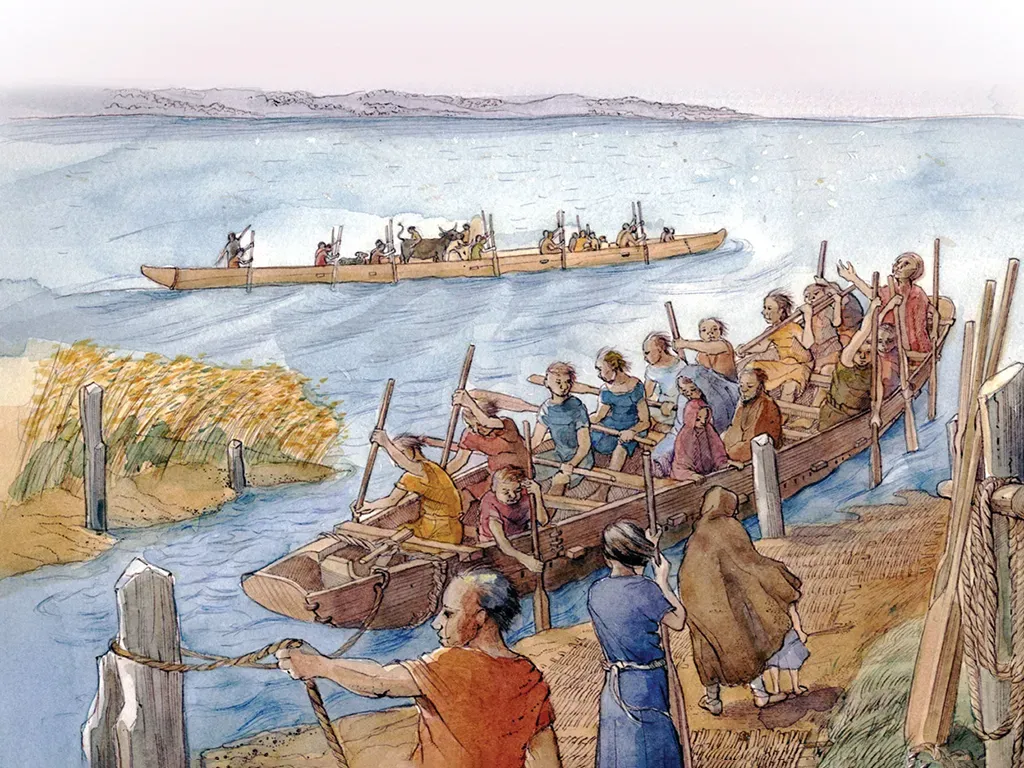 1: Dawn of Naval Architecture
1: Dawn of Naval Architecture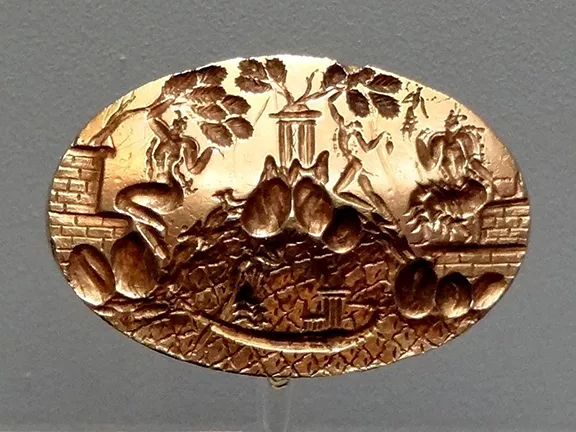 3: Middle Bronze Age c 2000 - 1600 BC
3: Middle Bronze Age c 2000 - 1600 BC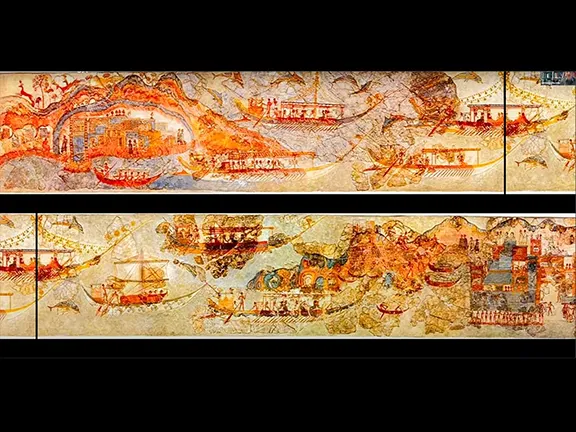 4: Late Bronze Age c 1600 - 1200 BC
4: Late Bronze Age c 1600 - 1200 BC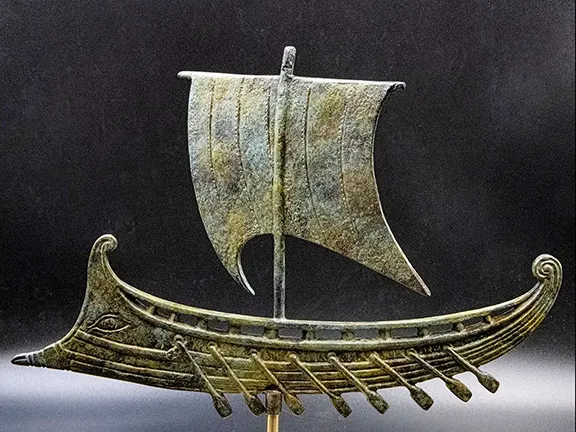 5: Early Iron Age 1200 - 700 BC
5: Early Iron Age 1200 - 700 BC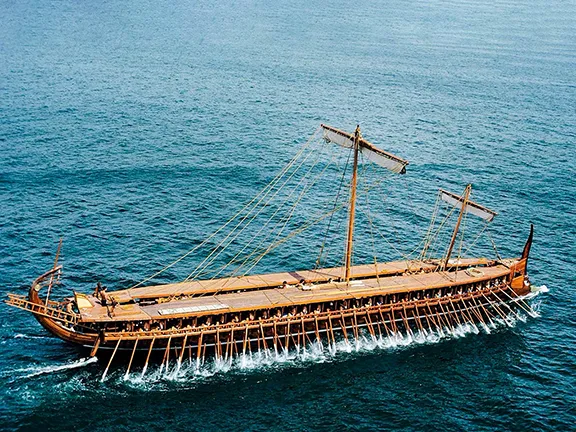 6: Late Iron Age c 700 – 264 BC
6: Late Iron Age c 700 – 264 BC 7: The Roman Era 264 BC – 400 AD
7: The Roman Era 264 BC – 400 AD